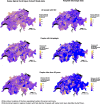Residential location of people with chronic spinal cord injury: the importance of local health care infrastructure
- PMID: 30134900
- PMCID: PMC6106887
- DOI: 10.1186/s12913-018-3449-3
Residential location of people with chronic spinal cord injury: the importance of local health care infrastructure
Abstract
Background: People with spinal cord injury (SCI) suffer from complex secondary health conditions and rely on specialized health care services, which are often centralized and difficult to reach for individuals living in remote areas. As a consequence, they might move to regions where they expect better access to care. The aims of this study were: 1) to identify regions where people with SCI live compared with the general population, 2) to examine whether their choice of residence is related to the availability of local health care infrastructure, and 3) to ascertain determinants of their consideration to change residence when aging.
Methods: This study used information from a nationwide Swiss SCI cohort and inpatient hospital discharge data. To detect clusters in the distribution of people with chronic SCI in Switzerland, a spatial cluster detection test was conducted using the normative population of a region as offset. To identify associations between the residential location of people with SCI and infrastructure variables, a negative binomial model was set up at a regional level with the frequency of people with SCI as outcome, geographical indicators as explanatory variables, and the normative population as offset. Determinants of the consideration to change residence when aging were investigated using logistic regression models.
Results: People with SCI were not living equally distributed among the normative population, but clustered in specific areas. They were more likely than the general population to reside close to specialized SCI centers, in areas with a high density of outpatient physicians, and in urban regions. People with SCI living in rural areas were more likely to consider relocating when aging than those living in urban areas. However, only a few people with SCI considered moving closer to specialized centers when such a move required crossing language barriers.
Conclusions: Good access to appropriate health care services and amenities of daily life seems to play such an important role in the lives of people with SCI that they are willing to choose their residential location based on local availability of appropriate health care services.
Keywords: Access; Disability; Environmental barriers; Health care infrastructure; Residential location; Spinal cord injury.
Conflict of interest statement
Ethics approval and consent to participate
This study was approved by the ethics committee of northwest/central Switzerland, and by the care and patient organizations where the contact addresses were collected.
Consent for publication
Not applicable.
Competing interests
All authors were salaried by organizations financially compensated by the Swiss Paraplegic Foundation or by the Clinique Romande de Réadaptation SUVACare.
Publisher’s Note
Springer Nature remains neutral with regard to jurisdictional claims in published maps and institutional affiliations.
Figures
Similar articles
-
Satisfaction with access and quality of healthcare services for people with spinal cord injury living in the community.J Spinal Cord Med. 2020 Jan;43(1):111-121. doi: 10.1080/10790268.2018.1486623. Epub 2018 Jul 2. J Spinal Cord Med. 2020. PMID: 29965779 Free PMC article.
-
[Care preferences and spatial mobility : Factors influencing care-related willingness to move of elderly people in partnerships in a rural area].Z Gerontol Geriatr. 2017 Apr;50(3):200-209. doi: 10.1007/s00391-015-0991-z. Epub 2015 Dec 9. Z Gerontol Geriatr. 2017. PMID: 26650034 German.
-
Health System's Role in Facilitating Health Service Access among Persons with Spinal Cord Injury across 22 Countries.Int J Environ Res Public Health. 2023 Jun 5;20(11):6056. doi: 10.3390/ijerph20116056. Int J Environ Res Public Health. 2023. PMID: 37297660 Free PMC article.
-
Spinal cord injury and aging: challenges and recommendations for future research.Am J Phys Med Rehabil. 2012 Jan;91(1):80-93. doi: 10.1097/PHM.0b013e31821f70bc. Am J Phys Med Rehabil. 2012. PMID: 21681060 Review.
-
Primary care of people with spinal cord injury: scoping review.Can Fam Physician. 2012 Nov;58(11):1207-16, e626-35. Can Fam Physician. 2012. PMID: 23152456 Free PMC article.
Cited by
-
Why Do Community-Dwelling Persons with Spinal Cord Injury Visit General Practitioners: A Cross-Sectional Study of Reasons for Encounter in Swiss General Practice.J Multidiscip Healthc. 2022 Sep 12;15:2041-2052. doi: 10.2147/JMDH.S382087. eCollection 2022. J Multidiscip Healthc. 2022. PMID: 36118137 Free PMC article.
-
Residential Mobility and Reasons for Moving Among People Living With Spinal Cord Injury: Results of a Multisite Survey Study.Top Spinal Cord Inj Rehabil. 2023 Fall;29(4):108-121. doi: 10.46292/sci23-00030. Epub 2023 Dec 1. Top Spinal Cord Inj Rehabil. 2023. PMID: 38076496 Free PMC article.
-
A Scoping Review on the Influence of Housing on the Health and Well-Being of People with a Spinal Cord Injury/Dysfunction.Healthcare (Basel). 2024 Dec 16;12(24):2537. doi: 10.3390/healthcare12242537. Healthcare (Basel). 2024. PMID: 39765964 Free PMC article.
-
Serious Injury in Metropolitan and Regional Victoria: Exploring Travel to Treatment and Utilisation of Post-Discharge Health Services by Injury Type.Int J Environ Res Public Health. 2022 Oct 28;19(21):14063. doi: 10.3390/ijerph192114063. Int J Environ Res Public Health. 2022. PMID: 36360940 Free PMC article.
-
Causes and length of stay of readmission among individuals with traumatic spinal cord injury: a prospective observational cohort study.Spinal Cord. 2023 Jul;61(7):383-390. doi: 10.1038/s41393-023-00874-6. Epub 2023 Feb 25. Spinal Cord. 2023. PMID: 36841915 Free PMC article.
References
-
- Brinkhof MWG, Al-Khodairy A, Eriks-Hoogland I, Fekete C, Hinrichs T, Hund-Georgiadis M, et al. Health conditions in people with spinal cord injury: contemporary evidence from a population-based community survey in Switzerland. J Rehabil Med. 2016;48:197–209. doi: 10.2340/16501977-2039. - DOI - PubMed
MeSH terms
LinkOut - more resources
Full Text Sources
Other Literature Sources
Medical
Research Materials


